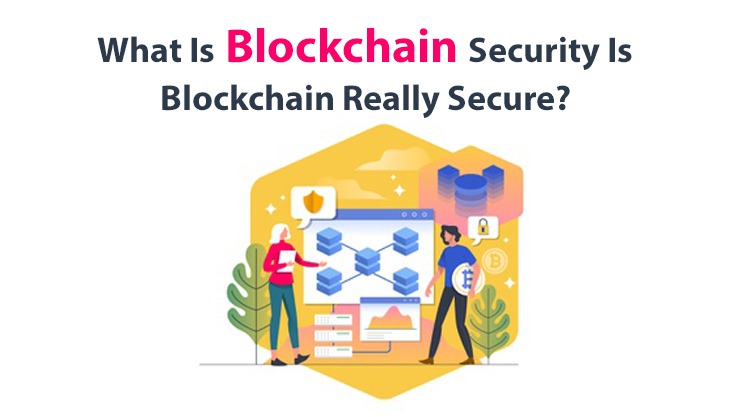What is Blockchain Security?
Blockchain security is a comprehensive risk administration practice for a blockchain network, using cybersecurity structures, support services and the most reliable approaches to overcome risks against attacks and scam.
Blockchain technology provides a composition of data with integrated security properties.
It's based on policies of cryptography, decentralization and consent, which assure trust in businesses.
Within most blockchains or distributed ledger technologies (DLT), the knowledge is structured into segments, and every block includes a transaction or bunch of transactions.
Every new component equates to all the sections before it in a cryptographic chain in such a process that it's approximately impossible to tamper with.
All transactions within the blocks are approved and agreed upon by a consent mechanism, guaranteeing that individual transaction is accurate and proper.
Blockchain technology permits decentralization through the assistance of members across a distributed network. There is no single point of failure, and a particular user cannot modify the report of transactions.
However, blockchain technologies vary in some significant security viewpoints.
Blockchain Security Issues
While blockchain technology offers a tamper-proof entry of transactions, blockchain systems are no immune to cyberattacks and cheating.
Those with evil intention can handle known vulnerabilities in blockchain foundation and have succeeded in numerous hacks and fraud.
Hackers and fraudsters endanger blockchains in four primary styles; here are several examples of blockchain security issues: phishing, routing, Sybil and 51% attacks:
1) Phishing attacks: Phishing is a scamming trial to achieve a user's credentials. Fraudsters export wallet key intended to seem as though they're coming from a reliable origin. The emails request users for their credentials using bogus hyperlinks. Having passage to a user's credentials and additional delicate information can result in problems for the user and the blockchain network.
2) Routing attacks: Blockchains rely upon real-time, massive knowledge transfers. Hackers can prevent data as it's conveying to internet service providers. In a routing attack, blockchain participators typically can't see the warning, so everything looks natural. Yet, behind the pictures, fraudsters have obtained classified data or money.
3) Sybil attacks: In a Sybil attack, hackers design and uses many malicious network identifications to flood the system and crash the network. Sybil refers to a popular book character diagnosed with multiple personality disorder.
Blockchain security tools
Blockchain, owing to its adaptable character, has a lot more to it than just cryptocurrencies.
It is one of the numerous disruptive and innovative technologies: the first permanent, decentralized ledger of reports.
It is undoubtedly a revolution in the operations of record.
1) Solidity: Solidity is the object-oriented programming language that is used to write bold arrangements and Ethereum-based applications. Its script is related to the JavaScript programming language, magnifying the Ethereum Virtual Machine. It is the runtime ecosystem in Ethereum. It is used for construction and expanding intelligent contracts on any blockchain.
2) Geth: Geth is a program that serves as the node of the Ethereum blockchain. Geth functions as a console for inserting commands and executing specific purposes. If any default preferences aren't set, it will automatically join the Ethereum mainnet. Be sure to use an external hard drive as a data warehouse, as Geth will automatically download the whole Ethereum blockchain. Geth is accessible on platforms such as Windows and Linux.
3) Remix: Remix is a compiler practised for small records. It maintains deploying, testing, and debugging of active contracts. Its code analyzer assists developers reproduce the most valuable codes. It correlates to the blockchain using Metamask, the browser extension, to secure Ethereum-enabled distributed applications (DApps). It is open-source and, therefore, can be used by anyone for free.
4) Mist: Mist is an authentic Ethereum wallet produced by the inventors of Ethereum. It is mainly used for deploying smart contracts. It is a full node wallet utilized to collect Ether tokens. One has to download the entire Ethereum blockchain, which is larger than 1 Terabyte, to use it.
5) Solium: Security plays an essential role in the advancement of a specific tool. The solidity code must be protected and tamper-resistant. It supports format solidity codes and also benefits fix security issues, if any, in the code. It is a tool that is intended to monitor for vulnerabilities in the code. It does not rigidly adhere to the Solidity Style Guide. It supports coding methods that the community has granted.
End Notes
When building a separate blockchain, assure that it's extended in a secure, flexible foundation.
Poor underlying technology options for business requirements and methods can point to data security dangers through their vulnerabilities.
Having explained the characteristics of these blockchain security tools, we now understand that using these is a significant step towards widespread blockchain security adoption, especially in the enterprise world.
















Post Comments